Appearance: Five different personal stamps marked ‘Nederland 1’, the denomination for post weighing up to 20g sent to an address within the Netherlands
Date of issue: 28 October 2021
Item number: 810060
Design: stamps Tim Ottens (Rijswijk), sheet edge Sandra Smulders (Gouda)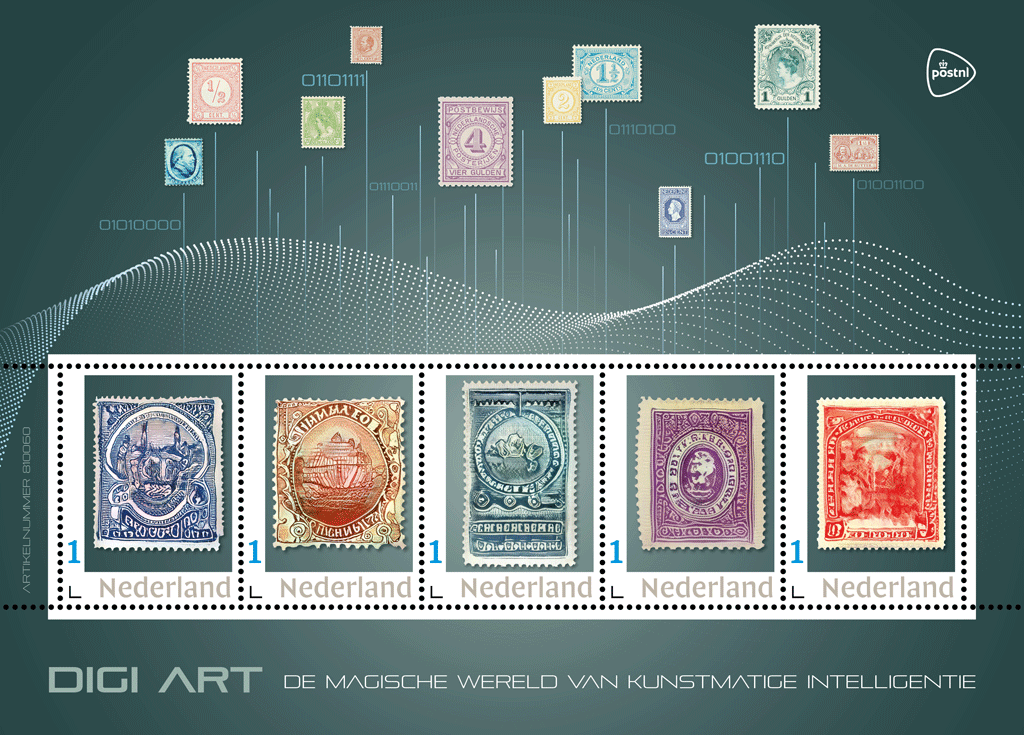 With the Digi Art issue, PostNL is the first postal company in the world to issue a stamp sheet with a design created by a computer algorithm. The Digi Art stamp sheet features five different personal stamps that were designed by an algorithm based on a collection of around 1500 stamps from the period from 1852 to 1920. The personal stamps are marked ‘Nederland 1’, the denomination for post weighing up to 20g sent to an address within the Netherlands.
With the Digi Art issue, PostNL is the first postal company in the world to issue a stamp sheet with a design created by a computer algorithm. The Digi Art stamp sheet features five different personal stamps that were designed by an algorithm based on a collection of around 1500 stamps from the period from 1852 to 1920. The personal stamps are marked ‘Nederland 1’, the denomination for post weighing up to 20g sent to an address within the Netherlands.
Background:
Artificial intelligence (AI) refers to computer systems that mimic human intelligence. These AI systems are capable of extrapolating large amounts of data, making new decisions and choices, and coming up with new interpretations. To achieve this, the computer systems use algorithms – mathematical formulas that are able to make independent decisions based on data or indicators – and learn from them. The developments in artificial intelligence are coming thick and fast. It is used in numerous applications, from face recognition on smartphones and self-driving cars to smart thermostats and deep fakes – digitally manipulated images, sounds and texts. Within AI there is a separate discipline called generative art, which is when a computer algorithm creates an original work of art or design. And this is exactly what was used for PostNL’s Digi Art stamp issue.
Design:
The stamp Digi Art stamp sheet features five postage stamps in five different designs. The 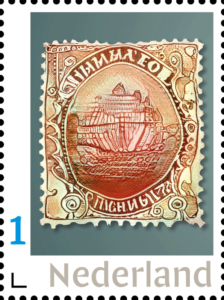 five stamps feature five unique computer-generated designs against a dark background. At first glance, the five stamps look as if they have been issued before, but appearances can be deceiving. They may look like classic stamps, but they are not. All the elements are familiar, such as a supporting picture in the centre with a frame around it, a strip at the bottom for text, decorations in the corners and a frame with perforations… and yet, they are different from the familiar stamps from the 1852-1920 period.
five stamps feature five unique computer-generated designs against a dark background. At first glance, the five stamps look as if they have been issued before, but appearances can be deceiving. They may look like classic stamps, but they are not. All the elements are familiar, such as a supporting picture in the centre with a frame around it, a strip at the bottom for text, decorations in the corners and a frame with perforations… and yet, they are different from the familiar stamps from the 1852-1920 period.
The sheet edge, which was designed by graphic designer Sandra Smulders, features ten old Dutch stamps. From left to right, these are: King Willem III 5 cents (1864), Numeral stamp ½ cent (1876), Queen Wilhelmina 20 cents (1899), King Willem III 7½ cents (1872), Postal order stamp 4 guilders (1884), Numeral 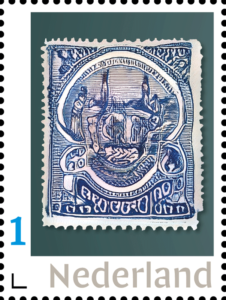 stamp 2 cents (1876), Numeral stamp 1½ cents (1899), Jubilee stamp 100 years of independence 12½ cents (1913), Coronation stamp Queen Wilhelmina 1 guilder(1898) and Michiel de Ruyter 1 cent (1907).
stamp 2 cents (1876), Numeral stamp 1½ cents (1899), Jubilee stamp 100 years of independence 12½ cents (1913), Coronation stamp Queen Wilhelmina 1 guilder(1898) and Michiel de Ruyter 1 cent (1907).
The 10 stamps are connected to the personal stamps with vertical lines via a horizontal elongated wave. The lines indicate the direction that the old stamps have travelled through the algorithm – represented by the wave – to form the new stamps. The background colour is derived from the personal stamp in the centre. The dark corners suggest depth. The gradient returns in the background of the stamps. In between the stamps, there are six individual letters in binary code (ones and zeros). The ones and zeros have different hues to symbolise the process of their creation.
Typography:
The font used for the denomination 1 and Nederland was designed in 2018 by font designer Martin Majoor from Arnhem. Pirulen Bold is used for the typography of the title, Pirulen Book for the binary code and Pirulen Light for the remaining text. All these fonts were designed in 2016 by Raymond Larabie of Typodermic Fonts in Nagoya, Japan.
Designer:
 The Digi Art personal stamps are the brainchild of Tim Ottens, data scientist with the Analytics & Decision Support team at PostNL. Ottens introduced the idea during a hack-time project: time he and his colleagues were allowed to spend on innovations not directly related to their own job. The result was so popular and the stamp colleagues at PostNL were so enthusiastic, that they decided to issue the Digi Art stamp sheet. During the creation process, Ottens worked together with Ying Yu, a data engineer at PostNL, to teach the computer algorithm to design new stamps.
The Digi Art personal stamps are the brainchild of Tim Ottens, data scientist with the Analytics & Decision Support team at PostNL. Ottens introduced the idea during a hack-time project: time he and his colleagues were allowed to spend on innovations not directly related to their own job. The result was so popular and the stamp colleagues at PostNL were so enthusiastic, that they decided to issue the Digi Art stamp sheet. During the creation process, Ottens worked together with Ying Yu, a data engineer at PostNL, to teach the computer algorithm to design new stamps.
Feedback
To explain how the algorithm works in practice, Ottens draws a comparison with the learning process of a real artist or designer. ‘Their designs are based on existing works of 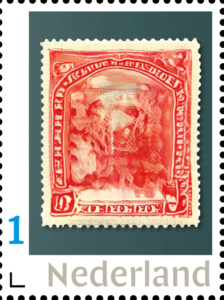 art, designs and impressions on the one hand and on feedback from others on the other. Generative art, so when an algorithm creates a design, works pretty much the same way. The algorithm also has to learn from existing works of art and designs plus feedback. To accomplish this, we need a considerable amount of data. In this case, we fed the algorithm a huge collection of images of old stamps. That’s what we call a dataset. When you have a good dataset, you get a balance between diversity and homogeneity. In other words, the stamps used as input for the algorithm must be different, but at the same time they should not be too different. That is why we focused on the more classic stamps from the period from 1852 to 1920.’
art, designs and impressions on the one hand and on feedback from others on the other. Generative art, so when an algorithm creates a design, works pretty much the same way. The algorithm also has to learn from existing works of art and designs plus feedback. To accomplish this, we need a considerable amount of data. In this case, we fed the algorithm a huge collection of images of old stamps. That’s what we call a dataset. When you have a good dataset, you get a balance between diversity and homogeneity. In other words, the stamps used as input for the algorithm must be different, but at the same time they should not be too different. That is why we focused on the more classic stamps from the period from 1852 to 1920.’
Marked stamps
Ottens started with a total dataset of 4500 different stamps from dozens of countries to feed the algorithm. This was whittled down to 1500 stamps over time. That is because the 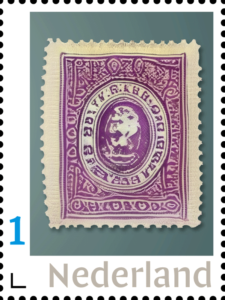 process ran across quite a number of obstacles. Ottens: ‘Images of marked stamps, for example. The algorithm doesn’t realise that it is a mark, so it teaches itself to create images with black splodges. So we removed all the marked stamps from the dataset.’
process ran across quite a number of obstacles. Ottens: ‘Images of marked stamps, for example. The algorithm doesn’t realise that it is a mark, so it teaches itself to create images with black splodges. So we removed all the marked stamps from the dataset.’
Noses
The next obstacle was the fact that many stamps feature faces. So when an algorithm creates new images based on these, you may end up with a face with two noses or no nose. ‘For an algorithm, this is only a small deviation, but we humans immediately notice that something is not right,’ says Ottens. ‘That is why we filtered all the stamps featuring faces from the dataset. And then there was the problem that the quality of some of the images just wasn’t adequate. We removed these by hand or adapted them to determine the final dataset. Sometimes, we offered the same stamps to the algorithm again, but in a different colour, or with a small piece cut off. Because the more variation you have in a dataset, the better the final result will be.’
Millions of evaluations
Ottens and Yu adapted open-source software to design the Digi Art stamps. This specific algorithm is able to learn unsupervised. This means that the algorithm discovers the 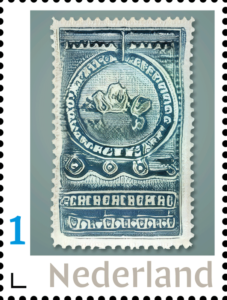 structure of the input itself and does not receive any commands relating to the desired output. In practice, there are two algorithms: the first is called the ‘generator’, the second the ‘discriminator’. Ottens: ‘The first algorithm functions as an artist who comes up with images from scratch. The second algorithm provides feedback by analysing the difference between the invented images and real stamps and passing this on to the other algorithm. By the way, the generator doesn’t just create a single image, it produces lots of them. That does take some computational time, the algorithms create and evaluate images millions of times.’
structure of the input itself and does not receive any commands relating to the desired output. In practice, there are two algorithms: the first is called the ‘generator’, the second the ‘discriminator’. Ottens: ‘The first algorithm functions as an artist who comes up with images from scratch. The second algorithm provides feedback by analysing the difference between the invented images and real stamps and passing this on to the other algorithm. By the way, the generator doesn’t just create a single image, it produces lots of them. That does take some computational time, the algorithms create and evaluate images millions of times.’
Human assessment
Ottens and Yu regularly checked a sample of the generated stamp designs. Ottens: ‘At first it didn’t look like anything, then slowly we saw outlines of stamps emerging. It started with the perforations and other recurring elements. During each assessment we tinkered with the program to give the algorithm a little push in the right direction. At some point we put together a longlist of the results and, together with our stamp colleagues, chose a number of designs. We didn’t adjust them any further, even the colours were picked by the algorithm. I am very happy with the final result, which far exceeded my expectations. Especially because sometimes unexpected details emerged. Like the double perforation on the centre stamp, for example. I couldn’t have come up with that myself.’
About the designers
Tim Ottens (Winterswijk, 1989) studied business economics, marketing intelligence and marketing management at the University of Groningen from 2010 to 2015. After 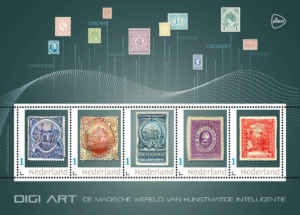 graduating, he worked as a data-analyst at T-Mobile for four years. In 2019, he moved to PostNL, where he is now a senior data scientist responsible for projects related to predictive modelling and artificial intelligence. He applies his knowledge and experience to, for example, the personalisation of the PostNL app. He also develops models for the prediction of package volumes and the time lapsed between the pre-advice and the actual delivery of the packages.
graduating, he worked as a data-analyst at T-Mobile for four years. In 2019, he moved to PostNL, where he is now a senior data scientist responsible for projects related to predictive modelling and artificial intelligence. He applies his knowledge and experience to, for example, the personalisation of the PostNL app. He also develops models for the prediction of package volumes and the time lapsed between the pre-advice and the actual delivery of the packages.
Sandra Smulders (The Hague, 1974) studied advertising and presentation design at Nimeto Utrecht from 1991 to 1995, specialising in graphic design. She started the Vormgoed agency in Gouda in 2007 as a graphic designer and art director. Smulders specialises in designing logos and corporate styles and further developing the associated means of communication. For PostNL Smulders also designed the Stamp Day 2021 and 2020 stamp sheets, the Back to the 20th Century and Trains & Journeys (2019) stamp series, the 2018 Children’s Welfare Stamps, the stamp series celebrating 50 years of the Daily Fable (2018) and the 25 years of Fokke & Sukke (2018) stamp series.
The stamps are available while stocks last at www.postnl.nl/bijzondere-postzegels and can be ordered by telephone from the Collect Club customer service on telephone number +31 (0)88 868 99 00. The validity period is indefinite.
Value:
The denomination on these stamps is ‘1’, the denomination for items weighing up to 20 g destined for delivery in the Netherlands.
Technical Specifications:
Postage stamp dimensions: 30 x 40mm
Appearance: five different personal stamps marked ‘Nederland 1’, the : denomination for post weighing up to 20g sent to an address within the Netherlands
Print run: 8,000 per issue
Item number: 810060
Design: stamps Tim Ottens (Rijswijk), sheet edge Sandra Smulders (Gouda):
Copyright: © 2021 Koninklijke PostNL BV



